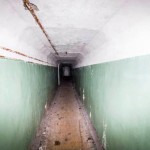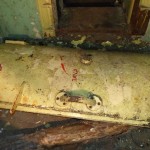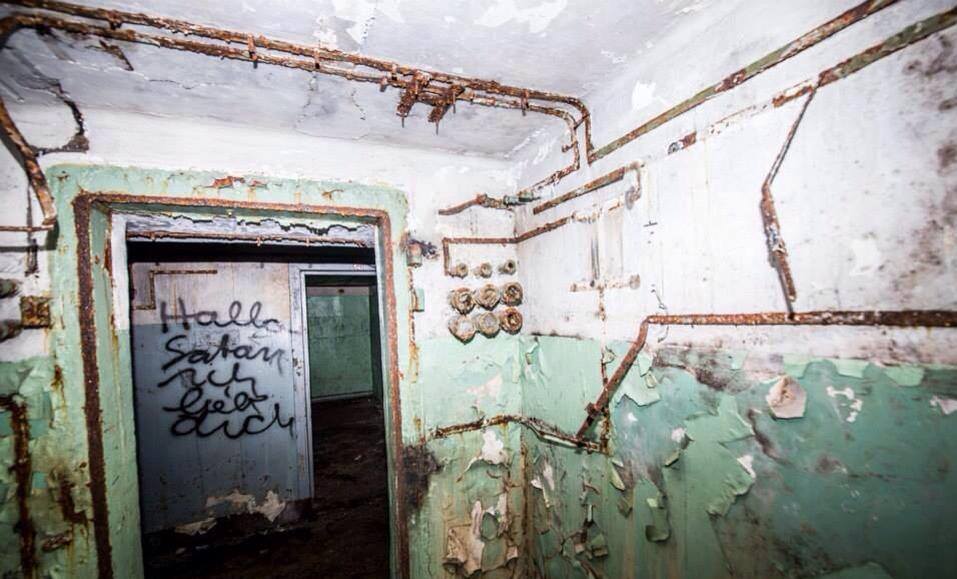Sometimes the temptation of clickbait-y headlines is too much to resist, but sometimes it leads you to something fascinating*. This was the case with a ViralNova post enticingly entitled “They Stumbled Across This In The Woods… Beneath It Was A Terrifyingly Awesome Secret,” which begins with “Deep in the woods in the middle of northern Germany…”
This piqued my interest for at least three reasons:
- Obscure history from World War II and the Cold War are a hobby of mine (and it seems safe to assume that any “terrifyingly awesome secret” found in a German forest dates to that period in history.)
- I find the idea of long-lost underground structures fascinating, albeit usually in a tragic way—like the abandoned tunnels in Ghostbusters 2, or the slightly-less-fictional “mole people” (not a very nice term) of Las Vegas, New York, etc.
- We’ve been watching the Sundance series Deutschland 83, which just had its season finale.
Deutschland 83 deserves its own post, but to summarize: It is about a young East German soldier sent to spy on West Germany by posing as the newly-assigned aide to a general in the West German Army. I haven’t seen much of the show The Americans, but I suspect they share some thematic similarities. As the title indicates, Deutschland 83 is set in 1983, the year we came closest to nuclear annihilation since the Cuban Missile Crisis 21 years earlier.
Getting back to the ViralNova post, it sets up the story as follows:
Deep in the woods in the middle of northern Germany there are strange, periscope-like pipes that are jutting out of the ground. One day, a group of friends stumbled across them in the former German Democratic Republic territory. They decided to explore the area, even though it seemed a little dangerous. What they found hidden beneath the ground was historically interesting … but also terrifying.
(By the way, if you want to avoid all of the spammy stuff, you can go directly to the Imgur album where ViralNova got the story.)



The explorers left when their camera battery died, but they never actually said what this place was. I did a bit of Googling and found a blogger who writes about urban exploration of, among other places, abandoned Cold-War-era sites in Germany. He won’t say exactly where this particular bunker is (and with good reason, I think), but in a blog post dated June 30, 2014, he recounts the story of driving five hours to the likely location, only to find the entrances bricked up or covered with locked steel doors. That’s when he explains why he’s not eager to share the exact location:
A five-hour journey almost completely in vain (and I still had another five-hour ride back). If I had a sledge hammer or bolt cutter with me, maybe I could have forced my way through the wall or the locked steel door, but that’s not how I do it. Things like that ruin the place for everyone, because the authorities have to take more extreme measures like burying the thing completely. I don’t know what caused the authorities to bury the entrances. Maybe the fact that the guys from the original imgur album “opened” a wooden lid over an entrance with a crowbar. Maybe they left it open when leaving, and a hunter (remember the deerstand right on top of the bunker) informed the authorities. Maybe it was all the fuzz about those photos on the internet that alerted someone in charge.
[Emphasis added.]
He says that this bunker is one of many facilities built by the Group of Soviet Forces in Germany (“GSSD” in German, “ГСВГ” in Russian), the official name for the post-WWII occupation force that never really left East Germany until East and West Germany became just Germany again.
It appears that the GSSD was very busy building bunkers (as many as 1,200) in East Germany. One of them, historians think, was intended to serve as the command center for the Warsaw Pact, should World War III ever break out against NATO. A 2010 article in the German newspaper Spiegel describes a Soviet plan for a preemptive attack that would have combined nuclear strikes with a massive ground invasion, overwhelming enough for Warsaw Pacts forces crossing into Germany from Poland and Czechoslovakia to be able to reach Denmark and the Rhine in less than a week. The plan had the sort of ruthless efficiency that probably would’ve made Stalin proud:“The attacking soldiers were supposed to reach the banks of the Rhine before any of them showed symptoms of radiation sickness,” says Polish historian Pawel Piotrowski. The plan was then to relieve these radiation-contaminated troops with units of the “Second Strategic Squadron.” NATO officials called this the “Polish-Soviet steamroller.”
The size and scope of this operation, according to the Spiegel article, suggests one possible purpose for at least some of the East German bunkers:
Such a colossal campaign would have required a war room — a nerve center to coordinate the various armies, air and ground forces, and missile brigades. But where was it located?
What historians do know is that if a major war had broken out in the 1970s, the commander-in-chief of the United Armed Forces of the Warsaw Pact, Leonid Brezhnev, would have moved to a bunker near Moscow. That’s where the lines of command would have converged.
In Legnica, Poland, 20 kilometers (12.5 miles) east of the Oder River, which runs along the Polish-German border, a key advanced command post was located which is thought to have been the coordinating headquarters for the whole of Europe. A total of 300 generals and 60,000 soldiers were constantly stationed there.
***
This command post was too far away, however, for a blitzkrieg fought in the region between the Elbe and the Rhine. What’s more, documents show that the operational command for this major assault on the West was to be in the hands of the high command of the Soviet armed forces in Germany.
The top commanders of this unit lived on a military base in Wünsdorf south of Berlin, although during a state of heightened alert, they would have immediately fled to another location. The base’s cover had been blown — NATO had spotted it.
Where would the top brass have gone? What hiding place would they have selected for a nuclear war? That is the key question.
What really gets me, aside from the scale and extent of the plans for WWIII barely thirty years ago, are the facts that these bunkers are apparently all over Europe, and historians have almost no idea what they were for. Did the Communists destroy the records? Or were they just especially tight-lipped about it?
It wasn’t just the Soviets, either. In 2014, The Independent reported the discovery of a massive underground bunker system built by the Nazis in Austria, where they worked on an atomic weapons program that (thankfully) never built an atom bomb.
It wasn’t just East Germany, either. Albanian communist dictator Enver Hoxha had as many as 750,000 bunkers (most small, some large) built in a country small enough to fit between Houston and Dallas. In a country of about 3 million people, that was roughly one bunker for every four people. (The guy was quite paranoid.)
![Photo of bunker on Albanian/Macedonian border by Fingalo (Own work) [CC BY-SA 2.0 de (http://creativecommons.org/licenses/by-sa/2.0/de/deed.en)], via Wikimedia Commons Photo of bunker on Albanian/Macedonian border by Fingalo (Own work) [CC BY-SA 2.0 de (http://creativecommons.org/licenses/by-sa/2.0/de/deed.en)], via Wikimedia Commons](http://crypticphilosopher.com/wp-content/uploads/2015/08/800px-07Albanisch_makedonische_Grenze02-150x150.jpg)
!["Triple bunker" by Elian Stefa, Gyler Mydyti (Concrete Mushrooms Project) [CC BY-SA 3.0 (http://creativecommons.org/licenses/by-sa/3.0)], via Wikimedia Commons "Triple bunker" by Elian Stefa, Gyler Mydyti (Concrete Mushrooms Project) [CC BY-SA 3.0 (http://creativecommons.org/licenses/by-sa/3.0)], via Wikimedia Commons](http://crypticphilosopher.com/wp-content/uploads/2015/08/Albania_triple_bunker-150x150.jpg)
!["Apartment with bunker in Shkodër (Albania)" by Jeroenvrp (Own work) [CC BY-SA 3.0 (http://creativecommons.org/licenses/by-sa/3.0)], via Wikimedia Commons "Apartment with bunker in Shkodër (Albania)" by Jeroenvrp (Own work) [CC BY-SA 3.0 (http://creativecommons.org/licenses/by-sa/3.0)], via Wikimedia Commons](http://crypticphilosopher.com/wp-content/uploads/2015/08/800px-Shkodër-apartmentwithbunker-2001-150x150.jpg)
The United States certainly has plenty of room for massive secret underground bunkers. How many are out there that, unlike the Greenbrier in West Virginia, or the much-more-fictional Crystal Peak in Terminator 3, we don’t know about?
* And that, I really hope, didn’t fill my computer up with spyware.
Photo credits: German bunker photos by hellomynameisthatthingfromthewalls, via Imgur; Map of German occupied zones by glglgl (svg version) [GFDL or CC-BY-SA-3.0], via Wikimedia Commons; Photo of bunker on Albanian/Macedonian border by Fingalo (Own work) [CC BY-SA 2.0 de], via Wikimedia Commons; “Triple bunker” by Elian Stefa, Gyler Mydyti (Concrete Mushrooms Project) [CC BY-SA 3.0], via Wikimedia Commons; “Apartment with bunker in Shkodër (Albania)” by Jeroenvrp (Own work) [CC BY-SA 3.0], via Wikimedia Commons.


![Map of German occupied zones by glglgl (svg version) [GFDL (http://www.gnu.org/copyleft/fdl.html) or CC-BY-SA-3.0 (http://creativecommons.org/licenses/by-sa/3.0/)], via Wikimedia Commons Map of German occupied zones by glglgl (svg version) [GFDL (http://www.gnu.org/copyleft/fdl.html) or CC-BY-SA-3.0 (http://creativecommons.org/licenses/by-sa/3.0/)], via Wikimedia Commons](http://crypticphilosopher.com/wp-content/uploads/2015/08/473px-Deutschland_Besatzungszonen_1945.svg_.png)
